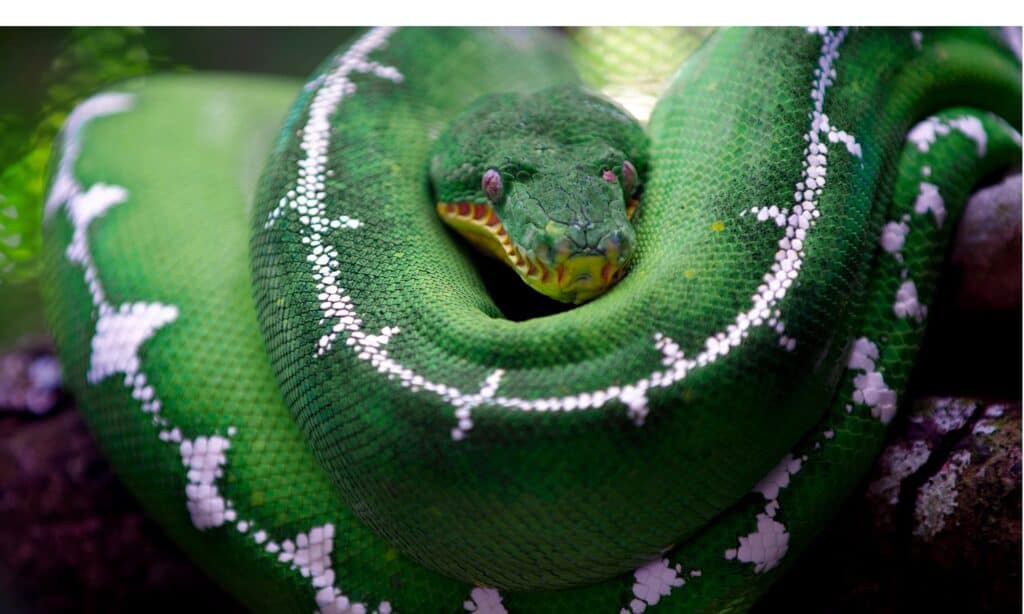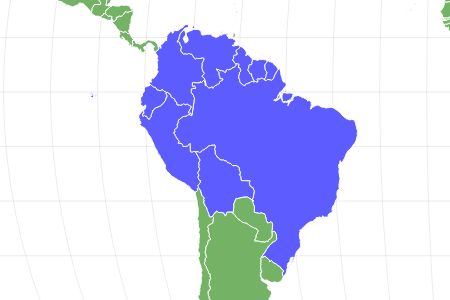Emerald Tree Boa
Corallus caninus and Corallus batesii
Their teeth are as long as a fully-grown reticulated python
Advertisement
Emerald Tree Boa Scientific Classification
- Kingdom
- Animalia
- Phylum
- Chordata
- Class
- Reptilia
- Order
- Squamata
- Family
- Boidae
- Genus
- Corallus
- Scientific Name
- Corallus caninus and Corallus batesii
Read our Complete Guide to Classification of Animals.
Emerald Tree Boa Conservation Status
Emerald Tree Boa Facts
- Prey
- Mice, rats, bats, birds, amphibians, reptiles
- Main Prey
- Rodents
- Name Of Young
- Neonates, snakelet
- Group Behavior
- Solitary
- Solitary except during mating season
- Fun Fact
- Their teeth are as long as a fully-grown reticulated python
- Biggest Threat
- Poaching for pet trade, possibly habitat loss.
- Most Distinctive Feature
- Bright markings over an emerald green base
- Distinctive Feature
- Large jaw muscles
- Other Name(s)
- Surinam, Guyana shield emerald tree boa, Amazon Basin tree boa, and northern emerald tree boa.
- Gestation Period
- 6-7 months
- Litter Size
- 4-16
- Lifestyle
- Nocturnal
- Common Name
- Emerald tree boa or Amazon Basin emerald tree boa
- Origin
- South America
- Number Of Species
- 2
- Location
- Central South America around the Amazon Basin and surrounding areas.
Emerald Tree Boa Physical Characteristics
- Color
- Red
- White
- Green
- Skin Type
- Scales
- Lifespan
- 15-20
- Weight
- Up to 1.5 pounds
- Length
- 4-6 feet (C. caninus) 7-9 feet (C. batesii)
- Age of Sexual Maturity
- 3-5 years
- Venomous
- No
- Aggression
- Medium
View all of the Emerald Tree Boa images!
Emerald tree boas are beautiful nonvenomous boas that live in tropical rainforests in South America.
They are native to the Amazon Basin and nearby regions in South America in the countries of Suriname, Guyana, French Guiana, Colombia, Brazil, Venezuela, and Peru. Like most snakes, they’re terrific rodent control. Some villages introduce them into their areas in order to control the rats and mice that follow human civilization.
Incredible Emerald Tree Boa Facts
- Emerald tree boas used to be lumped together as one species until scientists found enough evidence to split them into northern and southern species.
- Both the Amazon Basin emerald tree boa and the northern emerald tree boa have some of the largest teeth, proportionately, of any snake species.
- These snakes have very slow metabolisms, even for boas. An emerald tree boa may go for over a month between feedings.
Emerald Tree Boa Scientific Name and Classification
Emerald tree boas are nonvenomous members of the Boidae family. Some of their close cousins are boa constrictors and Cuban boas. Until 2009, there was only one snake species called the emerald tree boa. At that point, scientists split them into two:
- The northern emerald tree boa (C. caninus), native to a comparatively small region in eastern and southern Venezuela, northern Brazil, Guyana, Suriname, and French Guiana.
- The Amazon Basin emerald tree boa (C. batesii), which has a much wider distribution. This snake, as the name indicates, occurs in the Amazon Basin, from Colombia, Venezuela, Guyana, Suriname, and French Guiana in the north/northeast, to Peru, Brazil, and Bolivia in the west/southwest.
Their genus name, Corallus, is derived from the word coral. It may refer to the color or pattern of some of the Corallus genus snakes or of the juvenile snakes. The emerald tree boa’s specific name, caninus, describes its overall head shape and teeth. It’s sort of dog-like. The Amazon Basin emerald tree boa’s specific name is batesii. It was named after Henry Walter Bates (1825-1892), a British naturalist who spent 11 years in Brazilian Amazonia studying and collecting plants and animals.
These snakes go by a variety of names which include the Surinam, Guyana shield emerald tree boa, Amazon Basin tree boa, and northern emerald tree boa.
Emerald Tree Boa Appearance
Overall, these snakes look very similar to the green tree python, even though they are only very distantly related. They’re excellent examples of convergent evolution.
Both emerald tree boa species are very similar in appearance. They are long and slender but powerful snakes with huge, oversized teeth and jaw muscles. These snakes have long, prehensile tails that they use to hang from branches. Both species are green with white markings, although the northern snakes (C. caninus) can have yellow markings and lighter-colored bellies. They have very large, obvious heat-sensing pits along the upper and lower lips and gold or green eyes with vertical pupils.
However, there are enough differences between the two snakes that herpetologists agreed that they should be reclassified as separate species.
Color & Markings
The northern population is a brighter, more emerald green than the Amazon Basin population. Both species start out life as a brick red or reddish-orange color and change to their adult green over the course of their first year of life. Their markings are similar in that they’re usually stark white, roughly diamond, triangular, or lightning bolt-shaped, and generally evenly spaced down the length of their body.
The difference is that the Amazon Basin snakes have a full dorsal stripe that connects all the white markings and often black spots bordering the white, whereas the northern snakes do not. Northern emerald tree boas have creamy-white or yellow bellies, and the Amazon Basin emerald tree boas have yellow bellies.

Emerald tree boa coiled in tree
©outdoorsman/Shutterstock.com
Body Type and Head Shape
Northern emerald tree boas tend to be smaller and only average 4-6 feet long. However, their Amazon Basin cousins are bigger and can reach 9 feet long. Both snakes have a substantial feel to them; they’re not your typical “tree snake” with a shoelace-thin body. Males of these snakes are smaller than females, and they have larger spurs on either side of the cloaca that they use during mating.
Their scales are smooth and glossy, but it’s their heads that set them apart from other nonvenomous snakes. In addition to those teeth, which can be as big as a rattlesnake fang or a fully-grown reticulated python’s tooth, they also have huge jaw muscles that make their heads flair out at the back, making them look sort of like a venomous snake.
In a more subtle difference between the two species, the snout scales in the Amazon Basin snakes are much smaller than their northern counterparts.

The Amazon Basin emerald tree boas have a full dorsal line and are a darker green.
©iStock.com/Фадеев Олег
Emerald Tree Boa Behavior
Northern emerald tree boas have a reputation for being aggressive. While this may be generally true for wild-caught individuals, captive-bred snakes are much more docile. In contrast, the Amazon Basin emerald tree boas are said to be almost puppy-dog tame.
Both snakes have very strong feeding responses and may strike at nearly anything that moves, especially at night when they’re more active. However, it’s possible with some patience to teach these snakes that you’re not food or a predator out to get them. That’s not to say they make great pets if you want to handle them a lot. They can tolerate some handling but aren’t as interested in being held as other reptiles.
Emerald tree boas live at all heights in the trees. They have an extremely slow metabolism and don’t need to eat very often. When they’re not hunting, they stay coiled up on a tree branch, often hidden in foliage, with their heads resting in the center. They hang down from the branch when they’re hungry and try to grab at whatever they can or go hunting. Even though they’re fully arboreal, they’ve been known to cruise down towards the ground after prey.
Emerald Tree Boa Habitat and Diet
These snakes live in the rainforests of South America. Their tropical home is full of trees, foliage, and hiding places. They live up to 1,000m above sea level but can also be found near rivers and swamps. They’re not dependent on a water source, as the rain likely provides all the water they need.
Interestingly, studies on their stomach contents haven’t shown that they eat a lot of birds, as was previously assumed. Instead, their diet consists mainly of small mammals, especially rats and marsupials. Juveniles eat more frogs and lizards until they’re big enough to go after warm-blooded prey. They do eat birds on occasion and can snatch them out of the air, cutting right through the feathers with those giant teeth.
Emerald Tree Boa Predators, Threats, Conservation, and Population
The only animals known to prey upon adults are raptors. However, the juveniles probably fall prey to a number of animals larger than them.
Northern emerald tree boas are boas protected by CITES and the Brazilian government. According to the IUCN, the northern emerald tree boa and the Amazon Basin emerald tree boa are animals of Least Concern. However, in their assessments, they note that if poaching for the illegal pet trade continues, their population in the wild may diminish to dangerous levels.
Emerald Tree Boa Reproduction, Babies, and Lifespan
Their mating season usually falls between April and July. Females give birth to 6-14 babies after about 6-7 months of gestation but only mate every other year. Babies of both species are somewhere around 12-16 inches long and weigh 20-50 grams.
The emerald tree boa and the Amazon Basin emerald tree boa are genetically compatible and fully fertile hybrids occur both in captivity and in nature, making accurate identification in the wild sometimes difficult.
Next Up
- Green tree python. They may look like these boas, but they’re only distantly related.
- Amazon tree boas have been called “angry shoelaces.” They can be really temperamental and very fragile.
- Boa constrictors are also popular pet snakes and get even longer than the Amazon Basin emerald tree boa.
Emerald Tree Boa FAQs (Frequently Asked Questions)
How long are an emerald tree boa's teeth?
Measurements weren’t available when this was written, but they’re similar in size to that of a fully-grown 20-foot reticulated python’s teeth.
What do emerald tree boas eat?
Historically, scientists assumed that their primary diet consisted of birds and bats. However, more recent studies of their stomach contents indicate that their adult diet is rodent-based, and their juvenile diet is heavily amphibian and reptile-based.
What's the difference between Amazon Basin emerald tree boas and northern emerald tree boas?
Not much, but enough to be considered different species. The Amazon Basin snakes are bigger, darker, have a full dorsal stripe, and smaller snout scales than their northern cousins.
Where do emerald tree boas live?
Both species live in the Amazon Basin, but the northern emerald tree boas have a more limited distribution in eastern and southern Venezuela, northern Brazil, Guyana, Suriname, and French Guiana.
How do emerald tree boas hunt?
They mostly appear to be ambush predators, and dangle their heads from a tree branch while they wait. However, they may actively hunt rodents in the lower portions of the canopy.
Thank you for reading! Have some feedback for us? Contact the AZ Animals editorial team.
Sources
- Genus Corallus | West Indian Boas / Accessed August 9, 2022
- Corallus Daudin | Repositories Library of University of Texas / Accessed August 9, 2022
- Oubotar, P., Schargel, W. & Rivas, G. 2016. Corallus caninus. The IUCN Red List of Threatened Species 2016: e.T203208A2762180. https://dx.doi.org/10.2305/IUCN.UK.2016-3.RLTS.T203208A2762180.en. / Published November 22, 2014 / Accessed August 10, 2022
- Rivas, G., Gutiérrez-Cárdenas, P., Caicedo, J., Hoogmoed, M., Gagliardi, G., Cisneros-Heredia, D.F., Nogueira, C. & Gonzales, L. 2016. Corallus batesi. The IUCN Red List of Threatened Species 2016: e.T203207A2762173. https://dx.doi.org/10.2305/IUCN.UK.2016-3.RLTS.T203207A2762173.en. / Published October 23, 2013 / Accessed August 10, 2022
- Corallus batesii | Reptarium Reptile Database / Accessed August 10, 2022
- Corallus caninus | Reptarium Reptile Database / Accessed August 10, 2022


















